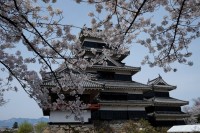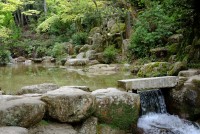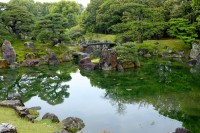Not long returned from a two week tour of Japan (or the main Honshu island at least). This was a trip we had been promising ourselves for a while, and decided that a tour was on balance probably the best way to get a sense of Japan in the time we had available. On reflection, we both agreed that the ratio of travelling to ‘experiencing’ was a little off kilter and might be improved by extending the length of the tour, but more on that later. After an eleven hour flight we had an initial two night stay in Tokyo. During our brief stay we managed to visit Meiji Jingu Shinto Shrine, the Asakusa Kannon Buddhist Temple, the Imperial Palace (grounds and moated area only) and the Tokyo Tower, from which we got panoramic views of the city. We learned early on from our guide that a Japanese sense of history and culture is a little metaphysical in approach. For example, a shrine will be considered as 1,000 years old if a building has always been based there, irrespective of the age of the current building. Tokyo itself is a typical, modern capital city. I’m sure if we’d had longer, we would have discovered its undoubted charms but our short stay left me underwhelmed. The Tokyo hotel did however introduce us to the extremely interesting, “multi-tasking” Japanese loo!

We travelled onto the Five Lakes District and the Mount Fuji area. The visit to the Visitor Centre was a little pointless as there was very little to see and Fuji itself was conspicuous only by its absence under dense cloud which, in fairness, is what about 90% of visitors actually get to see. We then motored onto Matsumoto, where the highlight of the overnight stay was the Matsumoto Castle (over 400 years old), visited at night and the following day. This timber and stone structure is one of only four original castles still extant in Japan and was well worth the visit. Very popular with tourists and locals alike and very busy even first thing in the morning. Also visited a family owned sake producing brewery and sampled a few varieties (with the obligatory opportunity to purchase). We then continued travelling, heading for Takayama via a stop off at the Hida Folk Village. Full of original, vernacular houses from throughout the Hida region, it’s a fine showcase for the lifestyles and culture of the region dating back to the 1700s. Takayama itself looked to be a town that would have rewarded some leisurely self-exploration, an opinion confirmed by the orientation tour on the first morning. Unfortunately, this walking tour was conducted in truly torrential rain and, although we had the afternoon free, even with waterproofs this short stay proved to be something of a washout. We did take the opportunity to sample a traditional Japanese coffee house (as far removed from Starbucks as you could possibly hope), as well as viewing the old government house (Takayama Jinya) and the beautifully decorated floats that are used in the Takayama Matsuri festival. The town deserved more time then we were able to give it, with plenty of cultural and historical attractions. Not for the first time on the trip, the weather let us down a little. We then moved on to Kanazawa visiting the World Heritage Shirakawago Village en-route. The village was a highlight of the trip. Something more akin to our cultural preconceptions around old Japan, this is a working and populated village, not a museum piece. We could have happily spent significantly longer here because the buildings and general environment were so interesting and, not least, because we got a decent break in the weather!
Spent the next morning in Kanazawa and visited the lovely Kenrokuen Garden, a garden with the characteristics of a typical landscape garden from the Edo period (1603 – 1868). Justifiably designated a National Site of Special Scenic Beauty, it would have been even more pleasant to walk around if the weather gods hadn’t decreed that we didn’t get drenched enough the previous day and dutifully turned on all the taps as soon as we stepped over the garden threshold. We also had the opportunity to visit Buke-Yashiki (A Samurai House). Built for a middle-ranking samurai family during the early 18th century, Buke Yashiki is a well preserved house and garden. Interesting and beautiful home that managed to give some insight and perspective into the lifestyle of a well-regarded, middle to upper ranking samurai. It was then onwards and upwards as we transferred to Hiroshima by train (including the first of two trips on the Bullet train).

From Hiroshima, we spent the next morning on Miyajima Island, otherwise known as Itsukushima or Divine Island. The weather gods decided to give us a break today, and we were able to explore the island with the sun on our backs. You could easily spend two or three days here, exploring the Itsukushima Shrine, wandering the mountain paths, parks and woodlands and avoiding the wild deer and their frequent attempts to relieve you of your food, bags and maps. In the afternoon, we went to the Peace Memorial Park that houses the Flame of Peace, and visited the Atomic Bomb Museum. It would be inappropriate to describe the visit as enjoyable, but it was extremely moving and not to be missed. It is said that all Japanese kids visit this place to teach them about the horrors of war. Judging from the laughing, joking and the mobile phone snapping, I’m guessing it might be passing them by. Oddly enough, and pious it may be, but unlike many, I had no real desire to constantly photograph the clothing remnants of men, women and children whose skin had been burnt off in the aftermath of the bomb. In the evening we took the opportunity to sample some local Japanese food. Hiroshima’s most famous food is its own style of okonomiyaki. The local version of the dish is characterized by only a thin layer of batter and a generous amount of cabbage on top of yakisoba noodles. Popular toppings include oysters, squid and cheese (no oysters or squid for me though!). The dish is completed with bonito flakes, green laver and okonomiyaki sauce. We were served sat at a counter in front of the chef who prepares the meal on a large griddle. Went down very well with some local beer.
Next morning up bright and early and caught the Bullet Train To Shin-Osaka, had a brief lunch stop in the old capital of Nara (including a visit to the famous, wooden Todaiji temple) and then on to Kyoto for a two night stay. In the afternoon had an initial look round old Kyoto, including the Gion area, which is apparently Japan’s most famous Geisha district. The local guide told us that there was a lively jazz scene in Kyoto and so a few of us went along to a recommended jazz club. The quartet in residence played a very good, if largely John Coltrane fixated set, interspersed with some surreal and very funny interjections from the Master of Ceremonies that appeared to involve significant amounts of plugging of merchandise.

Next day, we visited the Ryoanji Temple, a Zen temple with a famous rock garden (surprisingly small), and also the beautiful Kinkakuji Temple, or the ‘Golden Pavilion’, whose top two floors are completely bedecked in gold leaf. The Pavilion is a magnificent site, and the attached gardens are also very fine. These visits were made all the more enjoyable by another day of sun and warmth. Had the weather Gods finally relented? We also took in a traditional tea ceremony. In the afternoon we did our own thing and wandered around the Kyoto indoor markets, which are something to behold, and also had another amble around the Gion area. Gion has a high concentration of traditional wooden machiya merchant houses. Due to the fact that property taxes were formerly based upon street frontage, the houses were built with very narrow facades but extend up to twenty meters in from the street, all of which is fascinating to explore in your own time. At night we decided to go to the cultural show held every day at Gion Corner at the end of Hanami-koji. Aimed at foreign tourists, the show is a highly concentrated introduction to several traditional Japanese arts and includes short performances of a tea ceremony, ikebana, bunraku, Kyogen comic plays and dances performed by real maiko. It’s a little perfunctory and clearly aimed at first timers, but you can’t come all this way and not go! Next morning we had very quick visits to Kiyomizu Temple, an independent Buddhist Temple and one of the most celebrated temples in Japan. It was founded in 780 on the site of the Otowa Waterfall in the wooded hills east of Kyoto, and derives its name from the fall’s pure waters; and to Nijo, a fortified castle built in 1603 as the Kyoto residence of Tokugawa Ieyasu, the first shogun of the Edo Period (1603-1867). It had several ornate audience halls and also unique ‘nightingale’ floors designed to replicate the sound of the nightingale song when stepped on. (A security measure apparently, but it wouldn’t have woken me up). All very interesting, but I was getting a bit ‘templed out’ by this stage and the shoes on / shoes off ritual was beginning to pall – just how quickly shallowness can develop when a little tired! Plus, it has to be said, most of the temples are hardly a haven of spirituality and tranquillity, not least because of all those pesky tourists everywhere (ahem).

Final stopover was to Hakone, where we took a cable car up to the Owakudani Hot Springs, lying in the crater of Mt Kamiyama, Unfortunately, perverse weather god was back and it was so foggy you couldn’t see a thing. The cruise on Lake Ashi was cancelled because it was too windy to take the boat out and so we travelled on to Tokyo for our overnight hotel stop before our flight home. The above might suggest we didn’t fully enjoy our experiences in Japan, which is not the case at all. We knew from the itinerary that there would be a lot of travelling and were prepared for it. What we hadn’t realised was that the travelling to visiting ratio would be quite so imbalanced. We often didn’t get enough time at place of real cultural or historical interest. The weather gods weren’t particularly kind either. I’m not sure there is an answer to this. If you want to see a lot of Japan, then travel is inevitable. My view is that the length of the tour needs extending and to have a few three night stopovers to allow for more free time and exploration, especially in places such as Hiroshima and Kyoto. At the end of the day however, are we glad we went? The answer is an unequivocal yes but I’m not sure we’d necessarily recommend the tour as currently put together. If we had been ten years younger, it would have been easy enough to visit the major cities ourselves, although some of the more remote (and interesting) locations would have been a little trickier to reach. And to top it all, Denise has returned with a particularly tasty bout of flu!
You can find a few of the photos we took along the way by clicking here.
